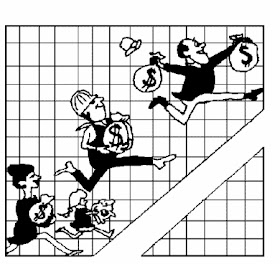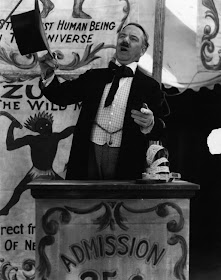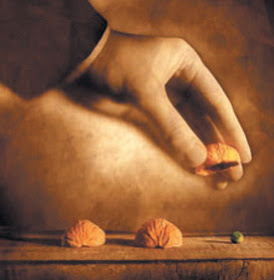I can't find anyone who was not certain that William Duer (above) was destined to die broke. A few of his friends even told him so - even some while helping him bankrupt themselves. At forty-five Duer was a slight built man with “sharp features and a receding hairline”, a man of “...dashing personality...with both talent and wit...” and “Making schemes every hour and abandoning them as instantaneously”. At its peak in 1794 his fortune was between $250,000 and $375,000 - over $4 billion today. But more, William Duer was the founding father who put the manic in America's first and succeeding economic depressions. Thomas Jefferson called him “The King of the alley”, meaning both the back alley, and "The Street", as in Wall Street,. He suckled at the breast of that most self destructive American midwife, Madam Laissez Fair. His bipolar greed added the purge to American gluttony. He was the American fingers on Adam Smith's invisible hand, always reaching for his partner's wallet. Let me give you an example.
The United States officially came into existence on 1 March, 1781, when the Articles of Confederation were finally ratified after four years of bitter debate. But economically America would not be a nation until all thirteen states shared a currency. Paper money was considered too risky to be legal tender, but coins had intrinsic value - in those days. In 1786 the Treasury Board accepted a bid from the firm of Jarvis and Parker to supply copper “Fugio” pennies (above), named for the Latin word meaning “I fly” stamped on their obverse.
Winning bidder, James Jarvis (above), suggested speeding up the process of issuing the coins by melting down the 30 tons of British copper pennies the Treasury already had on hand, and proposed paying for the copper out of his profits. And that little bit of economic legerdemain was the opening that William Duer needed to grab a little something for himself. You see, Duer was the head of the Treasury Board, appointed to that post by his friend and business partner, Alexander Hamilton.
According to James Jarvis, when they met in William Duer's New York City mansion to discuss the copper trade, Duer bluntly demanded a share of the business as a bribe. Jarvis says he was offended and ready to walk out, but then agreed so long as Duer remained a silent partner. Duer countered with a demand for a straight $10,000 bribe. Jarvis agreed to that too, but only if the business was successful. And that was what Jarvis thought he had agreed to, “relying on his (Duer's) honor”. Unfortunately Duer had no honor. Congress decided not to go along with the deal, so only few hundred “Fugio”'s were ever minted. Jarvis returned the unused copper, and that should have been the end of it. . But like a bad penny, William Duer turned up again, still demanding his $10,000 bribe.
Jarvis insisted he was not bound to pay Duer so much as “ten pence”. He insisted, Duer's “share... was conditioned on the success of the contract.” Duer simply ignored Jarvis' arguments and relentlessly demanded to be paid. And Jarvis relentlessly refused. Finally, at the end of September, 1788 Duer turned up the pressure, using his friends in Congress to demand Jarvis pay for the copper used in minting the few hundred “Fugio” pennies. The government already had the pennies. Now they wanted to be paid for the copper that was in them? Given the criminal treatment for debtors in those days, Jarvis was looking at some unpleasant jail time.
And just at this moment, Duer suggested that Jarvis might want to invest in another one of his schemes, an Ohio land speculation called the Scioto Company. Two shares were available, at $5,000 each. Anxious to be rid of the Duer, and reasoning that this way he at least got land that might some day be worth something, Jarvis gritted his teeth and sold off his coin stamping equipment, using the cash to pay a premium price for two sections of land in the “Scioto Company” Ohio reserve. Finally free from the villain (he thought), Jarvis left on a business trip to Europe.
A year later Jarvis returned and found he had no shares and no cash. He wrote to Duer's lawyers, “I demanded of Mr. Duer, the Ohio rights he was to have purchased for my account....He told me they were in the name of Doctor. J. Ledyard, and should be transferred to mine, in the company's books. I applied to...the treasurer, who informed me there were two shares in the name of Doctor Ledyard, but that he could not transfer them to me.....I have more than ten times applied to Mr. Duer, and...I could get no satisfaction....” It was a favorite tactic of Duer, to stubbornly refuse to admit he had stolen money, no matter the evidence or the law or common sense. Poor Mr Jarvis was so worn down by now, and so confused by Duer's shifting arguments, he seems to have forgotten they were arguing over the payment of an illegal bribe! Jarvis complained, “I have been three years amused in this business, it appears that he (Duer) should at least allow me interest (on his $10,000)..."
It was like speaking Greek to an Italian donkey. Duer (above) insisted he had sold two shares of the Scioto Company to Doctor Issac J. Ledyard. He (Duer) had been paid. He no longer had the shares. The company was supposed to transfer the shares to Mr. James Jarvis. So if Jarvis had a problem, it was with the company, not with Duer. It was perfectly logical as long as you forgot that the Scioto Company treasurer took his orders from William Duer. If you did remember that, Duer's arguments would eventually drive you insane. When the Scioto Company finally failed some years later, two shares were still on the companies' books as belonging to Doctor Isaac J. Ledyard. And there is no hint how many times Duer used Dr. Ledyard's two shares to bilk other partners. But for William Duer all this was a mere distraction to his tour de fraud with the Bank of New York.
The BNY was America's only private bank large enough to have its shares traded on the brand new New York Stock Exchange. Many people expected Alexander Hamilton, as Secretary of the Treasury Department, to eventually take over the BNY. And that was what William Duer assured his neighbor and new partner, Alexander Macomb. Blindly following Duer's instructions, Macomb bought 290 shares of the BNY, expecting to make a tidy profit as soon as Hamilton announced the Federalists were taking over the bank.
Of course, word that Alexander Macomb (above) was buying BNY stock sent the price climbing, which so impressed Macomb he wrote to a friend in London praising his partner. “Duer's genius assures him it can be done without any further capital farther than can be raised beyond our joint credit at the bank.” Of course, “joint capital” meant Alexander Macomb had co-signed Duer's loans, which meant the money had been raised on Macomb's reputation, not Duer's. By 1792 few people trusted William Duer enough to do that Macomb's investment encouraged even Walter Livingston, of the large and wealthy and powerful Livingston family, among others.
While in New York City, Alexander Macomb and William Duer continued borrowing and buying BNY stock (eventually $100,000 worth), in Philadelphia Walter Livingston (above) and William Duer were buying $160,000 shares of BNY futures, and buying them short. In other words Walter and William were betting against Alexander and William. Of course, Walter Livingston had also co-signed William Duer's Philadelphia loans. So without risking a penny of his own money, William Duer had bet both sides of the coin - heads he won and tails at least one of partners lost. It was predictable. .
Other members of the Livingston clan certainly predicted it, and Duer's involvement made them nervous. They began to withdraw the gold and silver they had on account at the BNY. That forced the directors of the bank to tighten their loan levels, and to raise the interest rates as high as 1% per day on just the sort of risky loans that Alexander Macomb and Walter Livingston had recently made. William Duer (above) tried to calm his New York partner, assuring Macomb, “I am now secure from my enemies, and feeling the purity of my heart, I defy the world.”
The world did not share the feeling. First Macomb and then Walter Livingston defaulted on their loans and were confined in the Manhattan debtors prison (above) . The financial panic spread and quickly caught up Duer as well. By the summer, William Duer was also in debtors prison, partly for his own protection, flat broke but not broken, claiming he could save his fortune if the banks would just let him free to repeat his old mistakes. The American economy teetered briefly on the edge of its first collapse, the recession of 1792, or what was called "Duer's Panic".
Five hundred of Duer's victims laid siege to the jail, chanting, “We have Mister Duer. He has our money.” Benjamin Rush, Congressional gadfly and gossip, went down to take a look, and described the victims as, “merchants and tradesmen, dray men, widows, orphans, oyster men, market women, churches, and even common prostitutes.” A lively trade developed on the streets around the jail in Mr. Duer's IOU's, and fights even broke out. One night a man broke into the jail, and confronted Duer with a pair of dueling pistols, demanding he pay what was owed or choose a weapon right there. Duer handed over what little cash he had on him and the would be duelist left..
The end, when it came, was long and drawn out. Confined in jail for seven years for debts he could never pay, William Duer died, probably of kidney failure, in April of 1799. He was only 57 years old. He left behind a widow unprepared for a life without wealth, and eight children. Alexander Hamilton wrote the first epitaph for William Duer, when he insisted, “There must be a line of separation between honest men and knaves, between respectable stockholders and dealers in the funds, and mere unprincipled gamblers.”.
The second, more permanent epitaph to William Duer was delivered on Thursday, 17 May, 1792 when 24 traders signed an agreement under a Buttonwood tree in front of 68 Wall Street. The two regulations they committed themselves to were, one, the signers would only trade with each other, and two, they would charge a ¼ of 1 % fee on each transaction. Like all practical market systems the New York Stock and Exchange Board was created by and survived because of regulations, designed by and for the majority of "respectable stockholders and dealers in funds", and not the manic gamblers flaming across the horizon.
Despite having only the Bank of New York and 4 other stocks to trade, a year after it was founded the New York Stock Exchange was successful enough to build itself a home, The Tontine Coffee House (above, left) on the corner of Wall and Water Streets. John Lambert would describe the Tontine as “filled with underwriters, brokers, merchants, traders, and politicians; selling, purchasing, trafficking, or insuring...Everything was in motion; all was life, bustle and activity...” But the attraction of the dramatic manic was there as well, even with the wreckage of William Duer still scattered about. Noted an observer in June of 1793, “There was an affray at the Tontine...(a fight) between...aristocrat and democrat.” A few months later the newspaper “Columbian Gazetteer” would complain, “only persons of the same party” remained at the Tontine." Wall Street, on its way to the panic of 1798, was again becoming addicted to the dramatic manic depressives in its nature, and likely always will..
- 30 -

























































